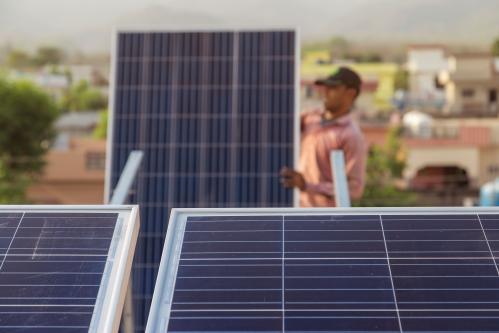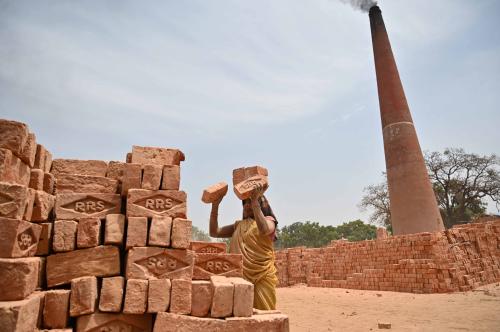This article was originally published in Finance & Development.
The COVID-19 pandemic showed us that human existence is fragile and perilous. However, if we do not take action now against climate change, the damage could be even greater and more lasting than the effects of the pandemic. Decisions made now are crucial in shaping the future of people and the planet. We must not go back to the old normal; it’s imperative to build back better through sustainable, inclusive, and resilient growth.
The 2018 Intergovernmental Panel on Climate Change (IPCC) special report Global Warming of 1.5°C highlighted the grave risks of global warming beyond 1.5 degrees Celsius, the already evident impact of climate change, and the limited time to arrest it. Projections show that more rapid and severe climate change will inflict greater harm on the environment, lives, and livelihoods. For example, warming of 2 degrees Celsius instead of 1.5 degrees Celsius would essentially wipe out all coral reefs on the planet, instead of 70 to 90 percent, and expose 37 percent of the population, instead of 14 percent, to extreme heat at least once every five years. Warming that exceeds 2 degrees Celsius significantly increases the risk of larger, likely irreversible environmental changes. The IPCC’s 2021 report documents the rapid acceleration of climate change, dramatically narrowing the window for limiting global warming from 2 degrees Celsius to 1.5 degrees Celsius and underscoring the imperative to reach net zero emissions by 2050.
If we do not take action now against climate change, the damage could be even greater and more lasting than the effects of the pandemic.
There is a growing realization that the risks and economic costs of climate change have been underestimated. If unchecked, climate change could displace hundreds of millions of people, mostly in the developing world, increasing the potential for conflict. Likewise, carbon-intensive economies depend on jobs that may be eliminated in the future to reduce pollution and avert catastrophic climate change. Jobs and incomes will be lost, driving many into poverty, and the longer decarbonization is delayed, the more disorderly future shocks will be.
Thanks to technological advances, the cost of renewable energy is declining, making it increasingly competitive with fossil fuels. Moreover, there is mounting evidence that decarbonization does not hamper growth, development, and jobs but instead offers a path to more inclusive, resilient, and sustainable growth; indeed it can “unlock the inclusive growth story of the 21st century.”
Investment and innovation
Increased spending on sustainable infrastructure has strong multiplier effects. In the short term, it can help the world economy recover from the effects of the COVID-19 pandemic by creating jobs and investment opportunities. In the medium term, it can spur innovation, create new sources of growth, and reduce poverty and inequality while delivering cleaner air and water. Over the long term, stabilizing climate change is the only path to a viable future.
To enable the shift away from carbon, governments must work with stakeholders to encourage clean energy and transportation systems, smart development, sustainable land use, wise water management, and a circular industrial economy. Major investment is needed to replace aging and polluting infrastructure, address infrastructure deficits and structural change in emerging market and developing economies, and protect and restore natural capital. In a report prepared for the Group of Seven (G-7), we asserted that the world must increase annual investment by 2 percent of pre-pandemic gross domestic product for this decade and beyond.
An even greater boost is needed for emerging market and developing economies (other than China) given their recent sharp declines in investment and need for financing to support growth, development goals, and structural change, including rapid urbanization. The coming two decades will be a crucial period of transition for emerging market and developing economies, requiring greater investment in all forms of capital—physical, human, natural, and social.
In developed and developing economies, investment offers significant potential to accelerate the transition to net zero through lower- and zero-carbon solutions, from sustainable aviation fuels to electric vehicles. The 2020 “Paris Effect” report finds that by 2030, low-carbon solutions could be competitive in sectors accounting for 70 percent of emissions, up from 25 percent today and none five years ago.
Greater support by governments and stronger international cooperation can help accelerate the pace of innovation, further drive down costs, and ensure the widespread availability of low-carbon technologies, including in developing economies. Developed and developing economies need greater investment and fiscal stimulus now to counter the effects of the pandemic while responsibly managing debt and deficits over the medium term. Fiscal policy, on both the revenue and expenditure sides, can promote the transition to low-carbon, inclusive growth, including through green budgeting.
Policies to accelerate change
Policymakers must set expectations and provide a clear sense of direction on how to achieve the net zero emissions target. To that end, the International Monetary Fund (IMF), the World Bank, and a growing number of academic, public, and private sector voices have called for elimination of fossil fuel subsidies and putting a price on carbon. A credible carbon price would send a critical signal to direct investment and innovation toward clean technologies and encourage energy efficiency. The IMF managing director said that “without it we simply cannot reach the goals of the Paris Agreement” and that “this price signal needs to get predictably stronger—by 2030, we need an average global price of $75 per ton of CO2, way up from today’s $3 per ton,” to be effective.
A credible carbon price would send a critical signal to direct investment and innovation toward clean technologies and encourage energy efficiency.
Along with carbon pricing, the transition to climate-resilient growth will require many different and mutually supportive policies given major market failures, the availability of other powerful and effective policy instruments, and political economy impediments. As outlined in a recent paper, governments and the private sector must:
- Reinforce carbon pricing with sector-specific policies—regulations, energy efficiency standards, feebates—and phase out coal.
- Boost public investment in sustainable and resilient infrastructure, including nature-based solutions—restoration of degraded lands and conservation of existing ecosystems—while mitigating the impact on the poor.
- Promote sustainable use of natural resources with policy measures such as payments for ecosystem services, regulations, reform of agricultural and water subsidies, and incentives for a circular economy to decouple economic growth from use of material resources.
- Deploy industrial and other policies to spur climate-friendly innovation, including in digitalization, new materials, life sciences, and production processes, with a focus on the coordination of policy areas and on long-term policies and policy planning.
- Provide information and promote public discussion on social norms and behavior to reduce energy demand and carbon intensity of consumption and business activity; educate the public about climate change risks and on early warning systems and evacuation plans in case of natural disasters.
- Align finance with climate objectives—manage financial stability risks posed by climate change; align social and private returns with green investment; mobilize resources for investment, including a major boost to international climate finance; and make monetary and supervisory policies consistent with net-zero-emissions objectives.
- Develop insurance instruments and social safety nets to mitigate the immediate impact of climate shocks.
- Foster a just transition with investment in and support for the shift to a low-carbon economy for affected workers, businesses, and regions—rapid change will involve dislocation in both production and consumption.
- Integrate sustainability considerations into public financial management and corporate governance; use better models and look beyond gross domestic product when deciding policy priorities and measuring well-being and sustainability.
By acting together on climate change, countries will benefit from stronger demand expansion and investment recovery, economies of scale, and lower costs for new technologies. The returns to collaboration and innovation are uniquely powerful at present given the high unemployment following the pandemic; the need for global access to COVID-19 vaccines; and the mounting threat of climate change, biodiversity loss, and environmental degradation. Failure to act on any of these threatens human health, economic prosperity, and the very future of the planet.
Mobilizing climate finance
Progress on global climate action will require commensurate ambition on climate finance. There are abundant pools of long-term savings, and interest rates are exceptionally low worldwide, but many emerging markets and most developing economies find it difficult to access long-term financing on the necessary scale, and the cost of capital is a major impediment to sustainable investment.
Developed economies’ commitment to provide $100 billion in climate finance by 2020 is not just symbolic but foundational to climate action. Credible progress on the $100 billion commitment is a make-or-break issue for the success of the coming conference and for climate action in the developing world.
Rich countries need to build on the G-7’s commitment by boosting climate finance in 2021-22 and doubling it to $60 billion by 2025. There is an urgent need to improve the quality of climate finance, by boosting grants from their present low level, immediately doubling finance for adaptation, and ensuring that at least half of concessional climate finance supports adaptation and resilience objectives.
Because of their mandates, instruments, and financial structure, multilateral development banks are the most effective source of support for climate action in developing economies and for the mobilization and leveraging of climate finance. These institutions must use all their powers and instruments at this moment of crisis, agreeing to triple financing by 2025 from 2018 levels. This will require an accelerated replenishment this year of IDA (the World Bank’s fund for assistance to the poorest countries), more effective use of development banks’ balance sheets, enhanced private sector finance mobilization, accelerated alignment with the Paris Agreement, and proactive capital increases.
Establishing the Resilience and Sustainability Trust within the IMF could also help bolster efforts, and proposals from the United Nations Economic Commission for Africa and the Bezos Earth Fund offer other ways to leverage concessional climate finance. The use of country platforms, which the Group of Twenty (G-20) has promoted but has yet to effectively apply, is another option to increase coordination.
Efforts to align the financial system with climate risk and opportunities are underway through the COP26 private finance agenda and in conjunction with initiatives such as the Financial Stability Board’s Task Force on Climate-Related Financial Disclosures, the Network for Greening the Financial System, the Coalition of Finance Ministers for Climate Action, the European Union sustainable finance expert group, and, most recently, the Group of Twenty working group on sustainable finance.
COP26 goals
For nearly three decades the United Nations has been assembling almost every country on earth for global climate summits. Under the U.K. presidency, this year’s summit will take place in Glasgow. The 26th Conference of the Parties on Climate Change (COP26), postponed for a year because of the COVID-19 pandemic, will bring together world leaders, scientists, businesses, public and private finance officials, climate activists, journalists, and other observers.
These are the key objectives for the Glasgow conference:
– Broad-based targets and a roadmap to secure net zero by mid-century and keep 1.5 degrees Celsius within reach, with ambitious action on carbon pricing, sector policies, phaseout of coal, and support for innovation.
– Support for adaptation and resilience, especially in poor and vulnerable countries, and for protection and rebuilding of natural capital.
– Mobilization of private businesses and climate finance to support these objectives and channeling of finance to emerging market and developing economies.
– Collective action to deliver these goals by finalizing the Paris Rulebook and accelerating collaboration. |
From pledges to action
U.S. Special Presidential Envoy for Climate John Kerry has described the coming conference, scheduled to begin in Glasgow on October 31, as the “last, best opportunity to get real” on the threat of climate change. The U.K. COP26 presidency, under the leadership of Alok Sharma, has set out priorities for the Glasgow conference: commitment to the net-zero-emissions target, stepping up action on adaptation and resilience, delivering on the $100 billion climate finance commitment, bolstering and transforming private finance, and increasing collaboration on all these objectives.
There has been encouraging progress already. At its June Carbis Bay meeting, the G-7 committed to net zero emissions by 2050, halving collective emissions over 2010-30, increasing and improving climate finance by 2025, and conservation or protection of at least 30 percent of the land and oceans by 2030. And, for the first time, the G-20 has signaled the need for action on carbon pricing. In the private sector, a growing number of businesses across all sectors have committed to net zero targets, and major financial institutions have set deadlines to take portfolios to net zero.
This decade will be decisive. What happens at national and international levels will determine whether the post-COVID recovery is strong and inclusive and whether we will embark on a new path of sustainable growth. If we get it right, we can usher in a new era of sustainable development with expanded opportunities for people across the world. Get it wrong and we will not only have a lost decade for development, but the people of the planet will be in great danger in the coming decades. We need to choose now, and we must choose wisely.
The Brookings Institution is committed to quality, independence, and impact.
We are supported by a diverse array of funders. In line with our values and policies, each Brookings publication represents the sole views of its author(s).







Commentary
Op-edOur last, best chance on climate
September 8, 2021